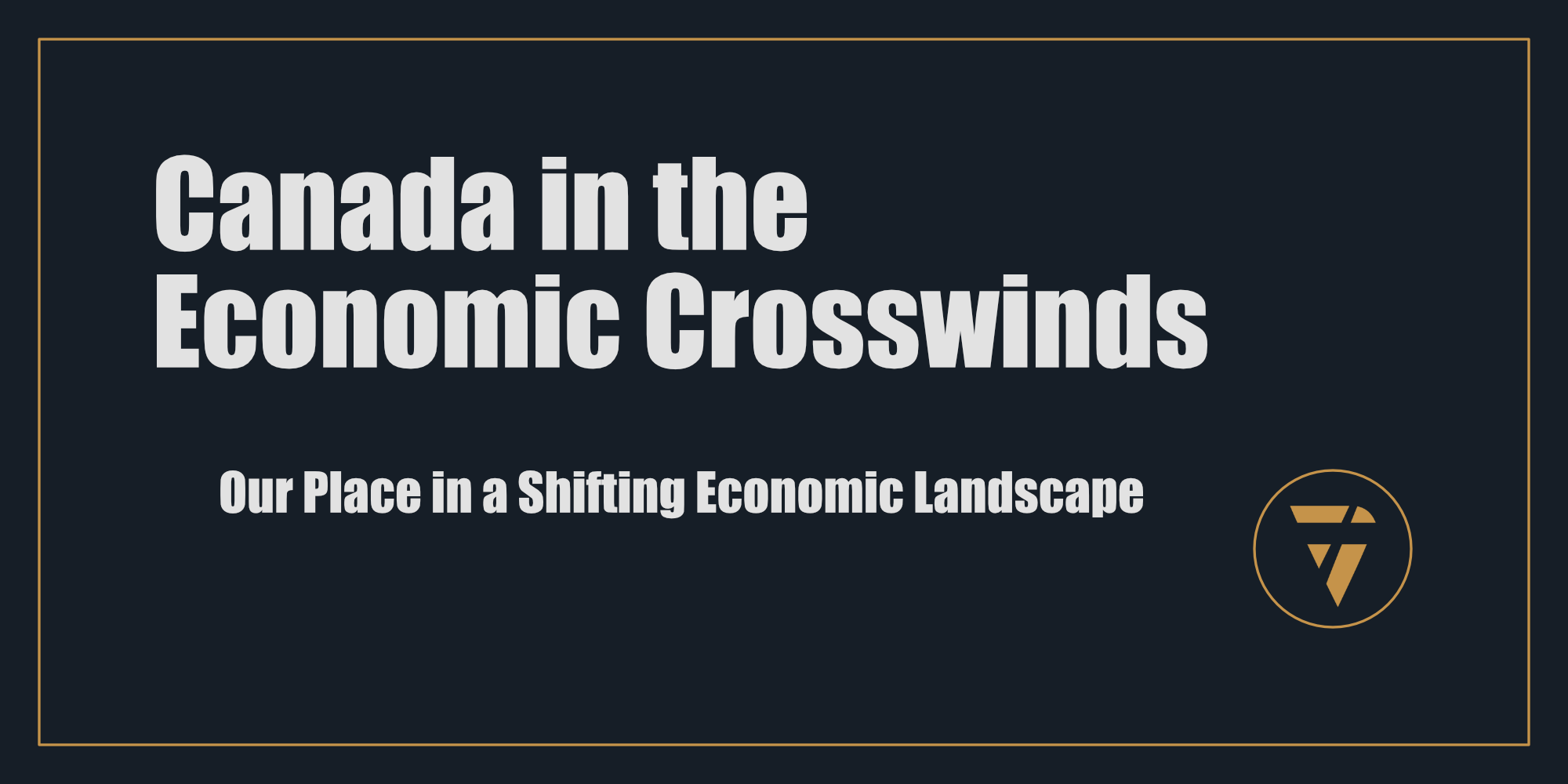Canada in the Economic Crosswinds

Our Place in a Shifting Economic Landscape
In a world increasingly defined by economic volatility, trade disputes, and financial realignments, Canada stands at a crossroads. As a country historically reliant on global trade, resource exports, and financial stability, we now face a stark reality: the economic systems that made Canada strong are under threat, and our next moves will determine whether we emerge as a stabilizing force, or a vulnerable casualty.
The Kindleberger Spiral looms in the background, not as a relic of history, but as a potential future event that Canada must navigate carefully. As protectionism rises, financial crises loom, and geopolitical tensions reshape global commerce, we must ask:
Where does Canada stand today?
What must we do to secure our future?
1. Canada's Strengths: The Foundation of Our Economic Stability
Canada enters this period of global instability with significant advantages. Our strengths provide a foundation, but only if leveraged correctly.
A. A Resource Powerhouse with Global Leverage
- Canada holds some of the world’s largest reserves of oil, natural gas, timber, fresh water, and rare earth minerals.
- In a world shifting towards energy security and critical minerals for technology and defence, our position is strategic.
- Nations outside the US are seeking trusted, stable suppliers. Canada must be proactive, not reactive.
Strategy: Strengthen trade deals with allied economies while securing domestic resource processing capabilities to reduce reliance on foreign supply chains.
B. A Stable Financial System Amid Global Uncertainty
- Canada’s banking system is among the most stable in the world, with strict lending regulations preventing the worst excesses seen in the U.S. and Europe.
- While high household debt remains a concern, our centralized banking structure provides resilience against financial shocks.
- We have the expertise and experience to manage, navigate, and direct whatever comes.
Strategy: Leverage financial stability to attract capital fleeing from unstable global markets, reinforcing Canada as a safe investment hub.
C. Strong Trade Agreements—But at Risk
- Canada benefits from USMCA (United States-Mexico-Canada Agreement), CPTPP (Comprehensive and Progressive Agreement for Trans-Pacific Partnership), and CETA (Comprehensive Economic and Trade Agreement with Europe).
- However, as the U.S. increasingly prioritizes protectionist policies, and China tensions grow, our trade positioning is more fragile than it appears.
Strategy: Diversify trade beyond North America by deepening ties with Europe, South America, and Indo-Pacific nations to avoid over-reliance on the U.S. and China.
2. Canada's Weaknesses: Vulnerabilities We Must Address
While Canada has a strong foundation, there are clear weaknesses that threaten our long-term stability. If left unaddressed, these could leave us exposed in a world increasingly defined by economic shocks.
A. Over-Reliance on the U.S. Market
- Nearly 75% of Canada’s exports go to the United States.
- When the U.S. economy experiences a major recession, Canada will feel the full impact.
- Growing U.S. protectionism threatens long-term Canadian competitiveness.
Solution: Accelerate market diversification efforts in Europe, Asia, and Latin America to reduce reliance on a single trade partner.
B. Manufacturing and Supply Chain Vulnerabilities
- Canada has outsourced much of its manufacturing base, making us dependent on international supply chains for key goods.
- A global economic downturn or trade war could leave Canada struggling to secure essential goods, from semiconductors to pharmaceuticals.
Solution: Incentivize domestic manufacturing in strategic sectors (technology, defence, pharmaceuticals, energy infrastructure).
C. Energy Policy Confusion & Underutilization of Resources
- Canada is one of the world’s most energy-rich nations, yet political indecision has prevented full utilization.
- The world is seeking reliable, ethical energy partners—yet Canada has hesitated to position itself as the answer.
Solution: Develop a balanced energy strategy that supports both traditional and renewable energy exports, ensuring energy security for Canada and its allies.
3. The Path Forward: Securing Canada’s Economic Future
Canada has a unique opportunity: we can be a stabilizing force in a world of economic turbulence, but only if we act decisively.
A. Become a Global Trade Stabilizer
- Lead efforts to strengthen international trade networks amid rising protectionism.
- Utilize Canada’s reputation as a neutral, reliable trade partner to position ourselves as an economic hub.
- Expand trade agreements beyond U.S.-centric policies to ensure resilience.
Action Step: Negotiate deeper trade ties with Asia, Brazil, the EU, and ASEAN nations while maintaining U.S. access.
B. Double Down on Economic Resilience
- Reduce foreign dependence in critical industries like technology, defence, and pharmaceuticals.
- Strengthen domestic supply chains to ensure Canada can withstand global trade disruptions.
- Encourage foreign investment into Canadian innovation rather than relying on raw material exports alone.
Action Step: Create federal incentives for companies to invest in high-tech and domestic manufacturing.
C. Assert Our Energy Leadership
- Canada should own the global energy transition, rather than be sidelined.
- Natural gas, hydrogen, critical minerals, and renewables are all growth areas, but we must lead, not follow.
- Leverage energy partnerships with Japan, Germany, and others to secure long-term demand.
Action Step: Implement a cohesive, long-term energy export strategy that aligns with global shifts while maintaining domestic energy security.
D. Strengthen Our Position in the AI and Digital Economy
- Canada is a leader in AI and advanced research, yet investment and commercialization lag.
- The next economic shift will be driven by AI, automation, and data dominance. Canada must be at the forefront.
Action Step: Expand funding for AI startups, advanced manufacturing, and next-gen computing to maintain global competitiveness.
Canada’s Moment of Decision
The world is entering an era of economic uncertainty. The Kindleberger Spiral, whether naturally occurring or intentionally engineered by global players, presents a very real threat to global stability. Canada is not immune.
However, Canada is also uniquely positioned to lead, if we recognize our strengths, address our vulnerabilities, and act with strategic foresight.
The choice is simple: we can either react to crises, or proactively shape our own economic destiny.
Will we be a stabilizing force in the global economy, or will we be swept up in its collapse?
Will we build economic resilience and independence, or remain vulnerable to external shocks?
Will we lead in global trade, energy, and digital innovation, or fall behind?
The future of Canada is not predetermined. It's built—decision by decision, strategy by strategy, and action by action.
The time to move is now.
This is what I’m working on. Tell me what you think, I enjoy the conversation! Subscribe and follow the work in real time.
Thanks!
B

Economic collapse isn’t always an accident. The Kindleberger Spiral is a weapon in the right hands. When markets fall, someone is collecting. Canada must decide: stabilizer or casualty? Secure trade, lead energy, own AI... or be swept under. The time to move is now.
PS -






